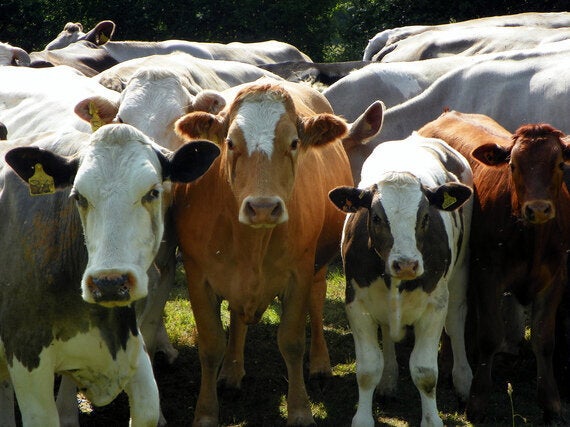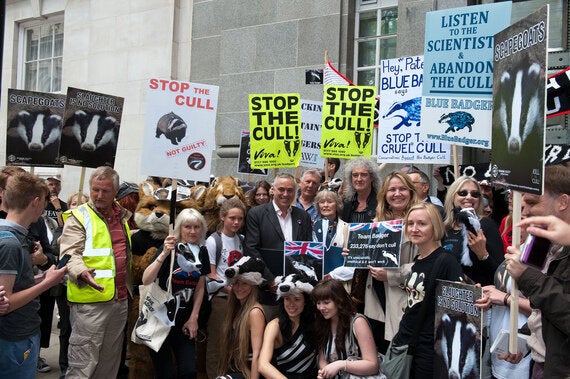
Badgers are undoubtedly one of the most iconic animals in the UK. However, in recent years they've had turbulent tribulations for their connections to the spread of TB to cattle. But now a new ZSL report has made a ground-breaking discovery, reinforcing the science behind why culling doesn't work, and outlines what new steps we need to take to manage Bovine TB.
But first, let's start with a recap:
Then
In 2013 Secretary of State Owen Paterson branded Bovine TB (bTB) as "the most pressing animal health problem in the UK", stating that 26,000 cattle were lost in 2011 costing around £100million; that the losses over the previous decade amounted to £500million; and estimated the cost to rise to £1billion over the next decade. These figures sparked outcry for a quick fix, and given the fact badgers were known to transmit TB to cattle the witch-hunt began.
The Mycobacterium they spread was dubbed bTB, suggesting it as an obligate pathogen to cattle (much like M. tuberculosis is obligate to us) however bTB can jump the species barrier and spread to other mammals such as deer, pigs and even people. The cruel irony is that cows can give it to healthy badgers, furthering their persecution yet leaving the cattle un-demonised.

Flickr | Peter O'Connor aka anemoneprojectors
Owen Paterson's rationale for the 2013-2014 trial culling period called upon previous research and the perceived success of previous culls from around the world. However the 1998-2005 Randomised Badger Culling Trial's (RBCT) final 2007 report found that localised, farm specific culls actually increased the spread within herds, and even when culls conducted over a much larger area (100km2) saw reductions in bTB transmission, infection occurrence still rose over time. This was reinforced by reports from before and during the 2013-'14 culling, suggesting that even 'successful' culls were not conducive to halting the spread.
The rise in infection incidence was due to the perturbation effect; a behavioural phenomenon which increases badger movement as population numbers and territories dwindle, thus increasing bTB spread. This was either not known to, or overlooked by, Owen Paterson when he authorised the 2013-'14 trial culls.
Paterson theorised if a cull were to be carried out over a large enough area for a sufficient length of time bTB spread would be eliminated. This is true but in order to be successful, whilst taking perturbation into account, would require the virtual elimination of badgers across the country. Despite the counter-reports and the fact Lord Krebs, the creator of the RBTC, labelled culling as "not a viable policy option" the 2013-'14 culls went ahead anyway.
These culls were considered successful at first, but when the rise in spread was seen again it was put down to not killing enough badgers instead of attributing it to perturbation effect. This misconception continued on to the 2015 cull, which again had no measureable impact in reducing bTB, and the fact remained: the farmers and participants of the culls were in fact jeopardising their livestock more so to bTB exposure.

This emotive issue has been contested since the culls were considered, with several experiments and scientific reports arguing counter solutions, such as changes in livestock management and vaccination schemes. For instance the 2011-2012 Wildlife Trust Vaccination Projects, spanning across 13 county areas, were a resounding success in both compassion and cost-effectiveness. It costs around £700 per badger to vaccinate, whereas during the 2013-'14 cull it came to approx. £7000 to kill each badger.
When presented with these findings, as well as the plethora of scientific data stacked against culling, there was still further demand for a 2016 cull. However, a new report by the Zoological Society of London (ZSL) not only reinforces the science of previous studies, but could also finally shift focus away from culling.
Now
In 2012 ZSL began a comprehensive study into badger/bovine contact to determine the cause of bTB transmission. The study used GPS collars to track both badger and cow movements, as well as proximity collars to record contact between collared badgers and collared cows within a 2m radius. CCTV was also used to monitor indoor spaces on the study farms.
The project ran until 2015 and collated the movements of over 60 badgers alongside cattle herd movements on participating farms. This took place across 20 study farms over the course of 5,500 nights. Smaller experiments were also carried out to determine specific badger/bovine responses to environmental stimuli associated with each species, and to define behavioural affects in relation to farm management practices.
Once the data was compiled it was concluded that collared cattle spend the equivalent of 8 years in the home ranges of proximity collared badgers, and the equivalent of 15 years in the home ranges of GPS collared badgers. However, despite the extended periods of sharing territory, the two species were never found in close proximity, and in fact were seldom less than 50m away from cows at all times. Thus leading to the conclusion that bTB is not spread by direct contact between badgers and cattle, but instead through their shared environment.
ZSL are currently trying to determine precisely where in the shared environment bTB is transmitted, but considering the rarity of badger/bovine contact this study alone may shift focus onto issues such as farm biosecurity and livestock management. A change in the way cattle farms are managed and secured would result in heightened prevention of bTB in both species.

This new data will hopefully not only spark an increase in farm biosecurity, but also re-establish the necessity for the much more compassionate vaccination approach. Instead of having a constant flux of expensive, ineffective culls, healthy badgers would be inoculated and infected individuals wouldn't have physical access to land currently shared by cattle, thus locally eradicating bTB in a matter of a few badger generations.
The money saved from future culling (which amounted to £14.2million during 2013-'14) could instead be pumped into funding badger vaccination schemes and cattle inoculation research, or into a subsidy programme to help farmers adequately bio-secure their farms.
By Thomas Phillips - Online Journalism Intern
Frontier runs conservation, development, teaching and adventure travel projects in over 50 countries worldwide - so join us and explore the world!
See more from our volunteers #Frontiervolunteer
